6 Sep 2024
PATA Youth Forums need to flip the format
Bangkok — PATA events tend to be a collection of visionary speeches, strategic thinking, forecasts and recovery plans. But no sooner does the situation begin to improve that another crisis strikes. One step forward, two steps backward. For this cycle to end, it will be necessary, nay imperative, to start listening seriously to the very people whose interests the PATA hierarchy claims to have most at heart — the future generation.
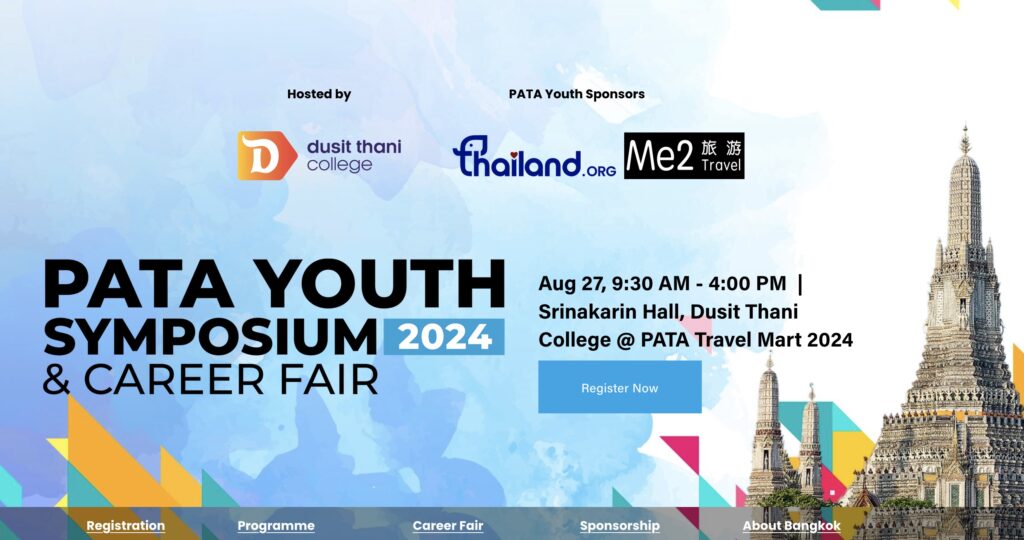
Let’s start with the PATA Youth Symposium and Career Fair, one of the side events of the Aug 27-29 PATA Travel Mart in Bangkok held at the Dusit Thani College. Students participated in a Roundtable Discussion and Youth Presentation which revolved around these three very relevant questions.
#1: Are you interested in pursuing a career in tourism and hospitality-related sectors?
#2: Why are you interested/not interested in pursuing a career in tourism and hospitality-related Sectors?
#3: What is the #1 topic that the youths want to discuss with the industry?
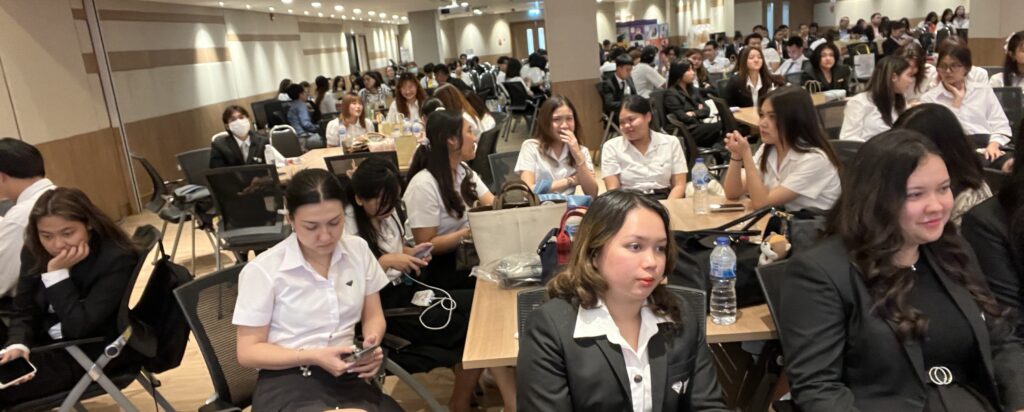

Regrettably, I was not privy to the answers. I missed the morning session of the Aug 27 Youth Forum as I was at the PTM2024 media briefing at the Foreign Correspondents Club of Thailand (FCCT). This image below, posted on the PATA social media network, offers some clues about what they talked about. The rest of the forum was devoted to discussing AI and Technology, Diversity, Equity and Inclusion, job prospects, how to draft applications, how to impress interviewers, etc.
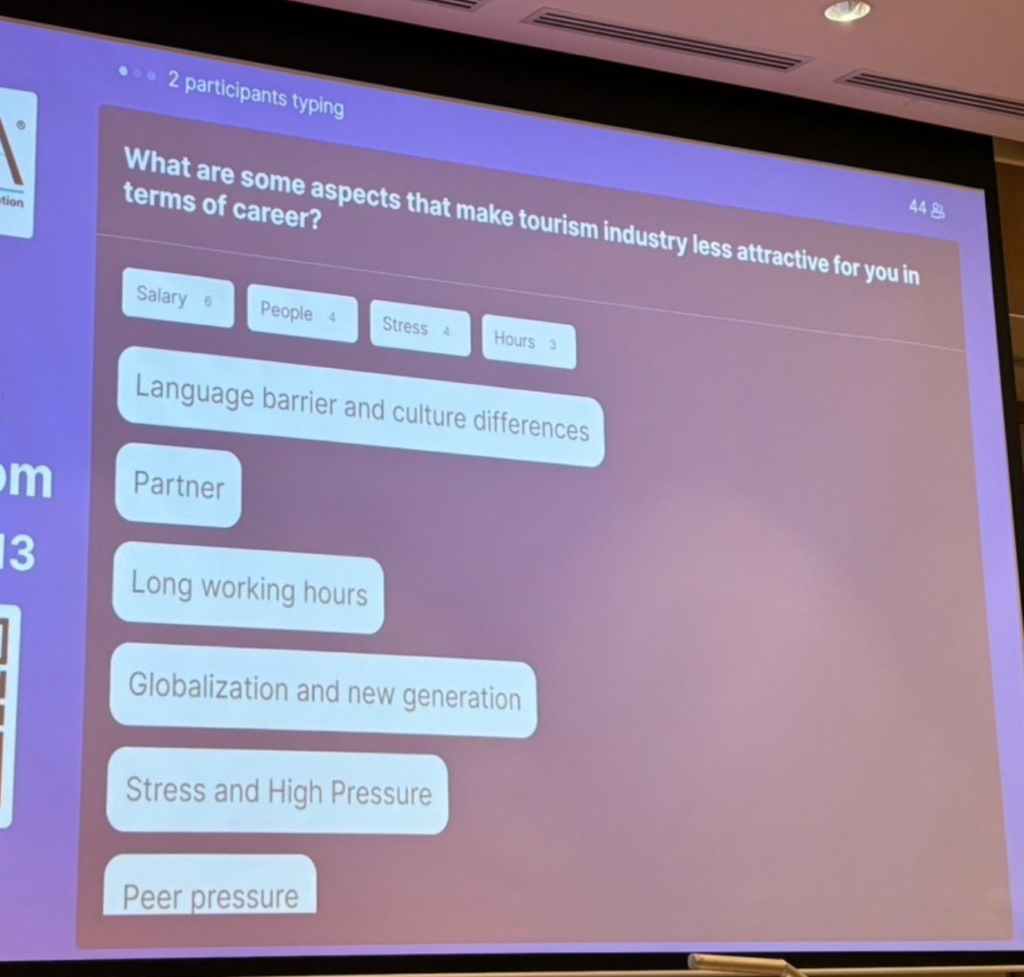
If the Young Generation wants to seriously pursue a career in tourism, these youth forums will need to flip the format. Instead of asking students for their views (the top-down approach), students should demand the right to question the decision-makers, academics and PATA executives and board members (the bottom-up approach) about their roles and responsibilities in shaping a better future. Questions such as:
1) What are chances of getting a decent job in Travel & Tourism at all, given the growing impact of technology, backlash against tourism and constant stream of destabilising crises?
2) If I do get a job, what are the chances of being sacked when the next crisis hits?
3) What criteria is used to decide who gets sacked and who stays? Which departments are the first to be targetted?
4) In terms of job security, working conditions and remuneration, does Travel & Tourism have anything better to offer vis a vis other economic sectors such as military-defense, telecommunications, finance, pharmaceuticals, etc?
5) Finally, what are Travel & Tourism leaders doing to improve the industry’s operating environment, job security and career development prospects?
Right after the Youth Forum, PATA Chairman Peter Semone and CEO Noor Ahmad Hamid came to the FCCT to make a presentation on visitor arrivals forecasts for 2024-2026. These forecasts are indicators of the industry’s future “health”. The “healthier” the industry, the more jobs it creates. Three scenarios were presented: mild, medium or severe.
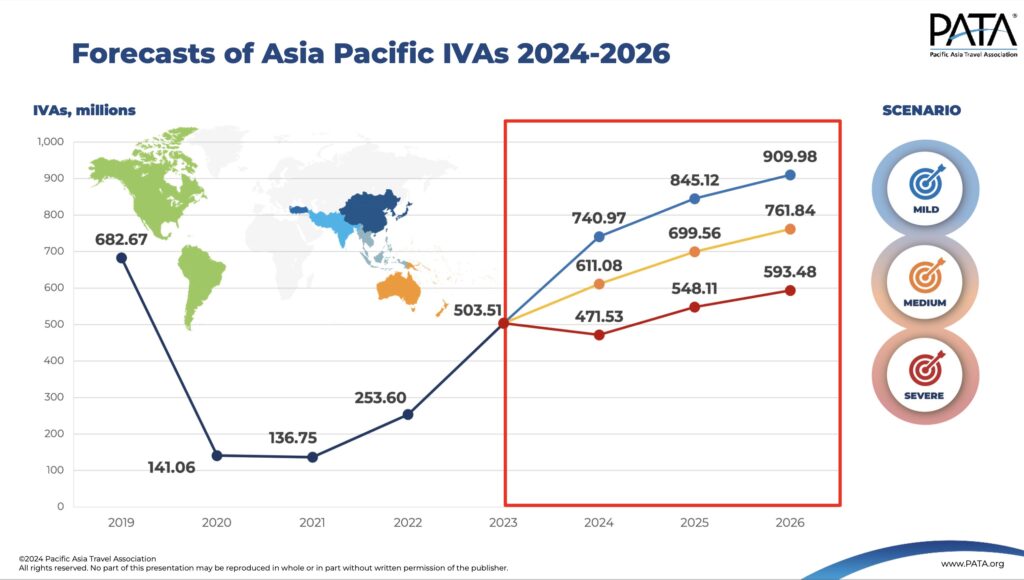
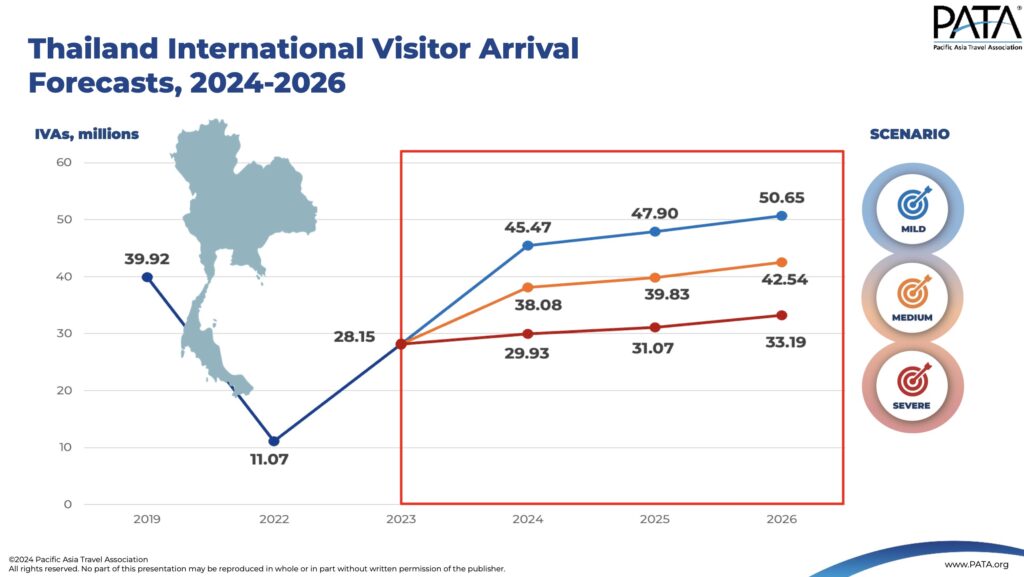
This slide below outlined what factors will determine the industry’s health outlook and PATA’s responses.
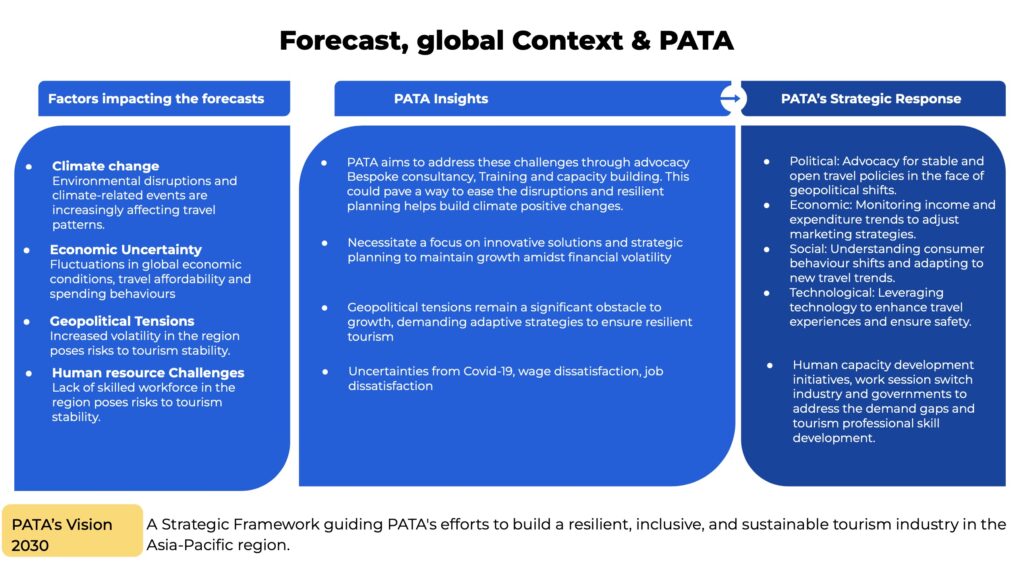
It is a far from exhaustive list. The risk factors (Factors Influencing the Forecasts) omit high-risk scenarios such as health pandemics, natural disasters and the rise of ethnocentric nationalism and religious extremism. These are curious omissions because jobs in the PATA region have been heavily impacted by all of them.
Covid, the most recent health pandemic, devastated Travel & Tourism and indeed just about every economic sector worldwide. As for natural disasters, 2024 marks the 20th year since the calamitous tsunami which destroyed large swathes of Sumatra island, Sri Lanka and the Andaman sea coastline. And as for ethnocentricism and extremism, the violence in Myanmar continues to cripple a country that is otherwise as well-endowed as Thailand in terms of culture and nature.
As shown on the slide, PATA’s strategic response to these risks and threats seems inadequate. All the prescriptions appear to be superficial remedies which treat the symptoms rather than the cause. The young generation would be right to ask how exactly they will help create a safe, secure, stable and sustainable industry in which they can find and keep their jobs.
In their comments at the FCCT, both Mr Semone and Mr Hamid noted the serious state of the operating environment. Mr Semone talked about the “existential threats” posed by raging geopolitical conflicts and the importance of peace. Mr Hamid noted that the entire business model has changed with the industry no longer dominated by the traditional hotels, airlines, tourist boards thanks to the entry of a new players some of whom “had never been heard of before.”
All well and good, but the brutal fact, judging from the roller-coaster PATA experience over the 25 years since it moved to Bangkok, is that travel & tourism needs at least five years, perhaps even more, of peace and stability in order for it to holistically regain its health. That recovery process also requires a correct diagnosis and treatment, which in turn requires probing the patient’s medical history.
That’s another missing link.
PATA, and the Travel & Tourism industry at large, is allergic to a study of history, especially that part of history which shows up its mistakes and failures. Such hindsight analysis raises questions about the reasons for the mistakes, who made them, and why. That’s when discussion shifts to living-in-denial mode. History then repeats itself.
Tourism academic institutions share the blame for this allergy to the study of history. At the Youth Symposium, I picked up a brochure of the Dusit Thani College MBA programme. Not a single course was offered on tourism history. The closest it came was crisis management. The same deficiency exists right across the collegiate of Thai tourism studies. If academia does not devote serious attention to analysing past industry mistakes, how does it expect the young generation to learn from them?


One of the most serious failures in tourism, and the least studied, is the decline in the brand and value proposition of PATA itself. At the PTM 2024, a lot of celebratory coverage was devoted to this being PATA’s 25th year anniversary since it moved to Bangkok. In 1999, PATA was at its peak, with 17,000 members . It is down to a less than 1,000 today. The youth forum participants could rightly ask PATA “thought-leaders” how they can offer prescriptive solutions to any industry problems when they couldn’t deal with their own.
Mr Semone and other industry CEOs also talked about the need for peace. Fine. What are they doing to preserve it? Some claim that PATA shouldn’t get involved in politics. Why not? Business leaders happily get involved in politics when they want politicians to cut taxes or remove visa impediments. They look the other way when the same politicians undermine democracy, freedoms and human rights on their own home turf.
Moreover, PATA has a programme known as the “Face of the Future”. Some of those “Faces of the Future” awardees dating back 20 years are now sitting on the PATA executive board. Chairman Peter Semone himself was also one of the PATA rising stars in the 1990s, and also served as PATA’s VP for Development. Clearly the current state of PATA and the travel industry is not the “future” they envisaged when they became its “face”. So what went wrong? What lessons are there to be learnt?
Fast forward to today. The way things are going, chances are that the PATA Visitor Arrivals Forecast is more likely to be “severe” by 2026. Which means that the young students who attended the Youth Forum will either have great difficulty finding a job or become a victim of the “last-in, first-out” sacking policy when the next crisis hits.
If PATA is to fulfill its mandate and responsibility to the youth, the primary job of its decision-makers is to make sure that future generation has one.
At the FCCT media briefing, Mr Semone said the industry needs a new set of measurement indicators. He said the current indicators of statistical visitor arrivals, expenditure and average length of stay is no longer relevant and needs to be replaced. The same could/should apply to measuring the success of industry leaders. Their leadership “success” should no longer be evaluated on the basis of how many more events, more members or more money they generated, but to what extent they made the industry safe, stable, secure and sustainable.
PATA, which claims to be the voice of the Asia-Pacific tourism, now wants the industry to become a force for good. Created by former UNWTO Secretary General Dr Taleb Rifai during his 2010-2017 tenure, that mission statement is a good benchmark. Following up on Mr Semone’s remarks, industry leaders should create new set of indicators and present an annual report card on how exactly they made Travel & Tourism a force for good.

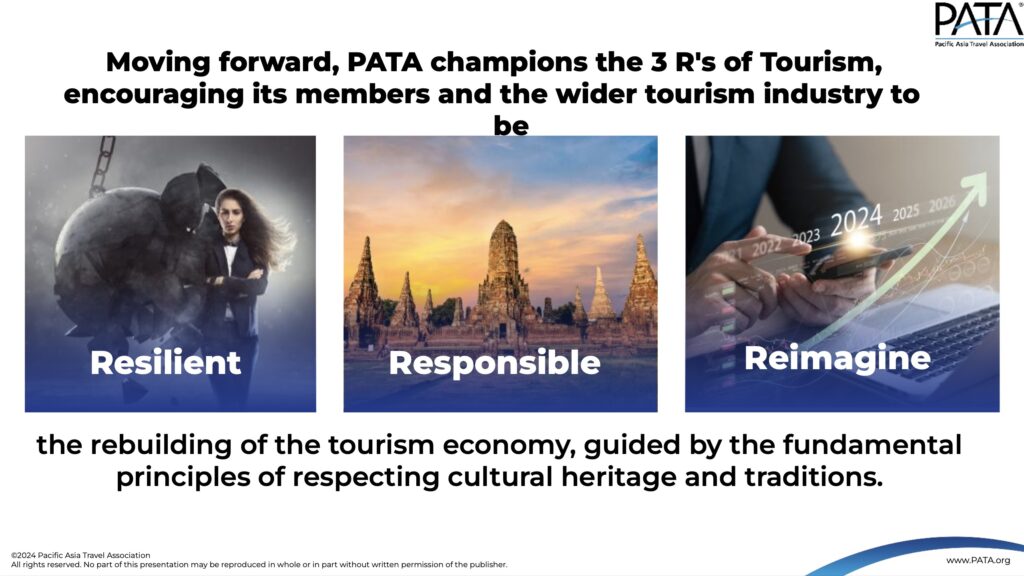
The core focus of the Youth Symposium was to create an environment that attracts the future generations and retains them. That is no different from attracting and retaining customers, the lifeblood of any business. When that environment is destabilised by man-made threats, those responsible need to held accountable.
If they truly want to be masters and mistresses of their fate, the PATA young generation needs to make that pursuit of accountability a clarion call mantra, and demand answers at every Youth Symposium, using the PATA forecast visitor arrivals scenarios as benchmarks.
One positive step in that direction was taken at the PTM 2024 when Mr Hamid made the call to hold PATA’s first media briefing at the FCCT. That showed a readiness to take potentially challenging questions from the media. The young generation should now demand equal treatment.
